In a global study done by Havas Meaningful Brands spanning 33 countries, 350,000 people and 1,800 brands, some interesting findings were found:[*]
-
Only 22% of brands are trusted.
-
Most customers would not care if 77% of brands disappeared.
-
58% of all content created by brands is poor, irrelevant or fails to deliver.
Suffering from “marketing overload,” customers are quick to cut ties with any brand that seems shady. They are craving authenticity.
Are you delivering? Bearded Brothers is.
Bearded Brothers, an all-natural and organic energy bar company, has harnessed customer trust through their simple marketing style and authentic origin story.

After speaking with Caleb Simpson, CEO of Bearded Brothers, here’s their magic recipe for running a simple marketing operation based on authentic relationships.
%(tableofcontents)
Chapter 1: Writing Your Own Authentic Brand Story
Caleb Simpson and Chris Herbert are the duo behind the all-natural Bearded Brothers energy bars. Their bars are certified organic, Non-GMO Project Verified, vegan, and gluten- and soy-free. I had the pleasure of speaking with Caleb. He took my call while going for a midday stroll in the wilderness of Austin. “I like taking calls while I’m walking,” he casually mentioned.
Caleb and Chris met because their wives are sisters! Caleb and his then-girlfriend, Kristy, spent a weekend with Chris and his then-girlfriend, Kaye in Austin. Caleb lived in Dallas with Kristy at the time and he shared with me that before he met Chris, he was a real “meat and potatoes” guy. He admitted that he was living an unhealthy lifestyle.
That weekend with Chris was transformative. Chris, an avid outdoorsman, introduced Caleb to a raw food diet. All the meals Caleb ate that weekend were vegan, which inspired him to shift away from a heavy meat diet and inactive lifestyle. He took up rock climbing, running, cycling, and making his own food. Over the last two years, he has transitioned from vegetarianism (a diet free of meat, poultry and fish) to a raw vegan diet.
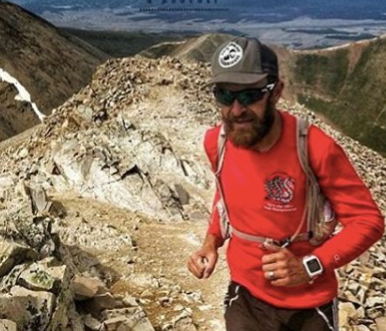
When Did Inspiration Strike?
While traveling on rock climbing trips, Caleb noticed that there weren’t a lot of healthy options for energy bars. Clif Bars had too much sugar. Lara Bars weren’t organic. Caleb was following an organic diet, so he decided to make his own bars. Unknown to him at the time, Chris was also making his own organic energy bars for work travel.
Caleb moved to Austin with his wife Kristy in 2010. With no job or freelance opportunity on the table, he approached Chris with the idea of starting a company to sell their energy bars. They found that Austin supported local brands and had the type of customer demographic with healthy, active lifestyles for their product. There was a gap in the energy bar market: the lack of an organic, gluten and soy-free, vegan, no sugar added, and independently-owned energy bar brand.
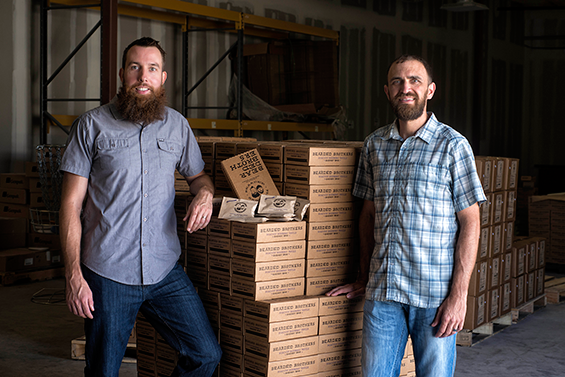
Caleb (pictured right) has a marketing degree from the University of North Texas and Chris (pictured left) has extensive experience in sales for the health supplements industry. Although neither one of them had direct food industry experience, they didn’t let that stop them. They learned all industry laws, how to lease a commercial kitchen, how to meet food requirements, how to package their products, and so on.
They started making their bars in their personal kitchen, progressed into renting a small kitchen, and now work out of a commercial kitchen. “We’ve grown naturally and organically. No pun intended.”

Who Thought Of The Name “Bearded Brothers”?
When asked how they landed on the name Bearded Brothers, Caleb said that came last. The company was first called Adventure Natural. He bought the domain name; created the logo and website. He was set on the name, until a friend flat-out told him the name sucked. None of their friends or family could remember it, which wasn’t good.
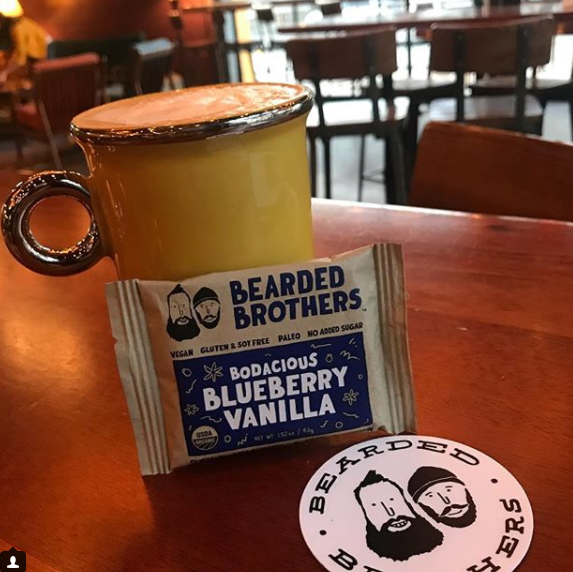
Caleb was resistant to change the name due to the amount of investment he already put into it. One day his wife said, “Why not call it Bearded Brothers.” So the next day, he went to Chris’s house to discuss the company name.
When finally sitting down with Chris, his wife Kaye suggests Bearded Brothers as well, before Caleb mentioned the conversation with his wife, Kristy, the night before. Caleb took it as a sign that the company name should be “Bearded Brothers.” They were brothers with beards after all.
Key Takeaway: Authenticity starts with the brand story. Be truthful and transparent about why your business matters to you. Think about why you’re the right person to execute it. Start by listing problems in your life and possible solutions.
Chapter 2: Selling Offline By Giving Away Free Product Samples
Caleb and Chris launched Bearded Bros with $5,515 from a Kickstarter project. They’ve taken great care to keep their burn rate low; minimizing spending money faster than they make money.
Some tech startups have a notoriously high burn rate given their extensive access to funds. Non-tech companies have to be more savvy by nature because they don’t have the same monetary cash flow as most tech companies. For Caleb, spending lots of money on marketing just didn’t make good business sense.
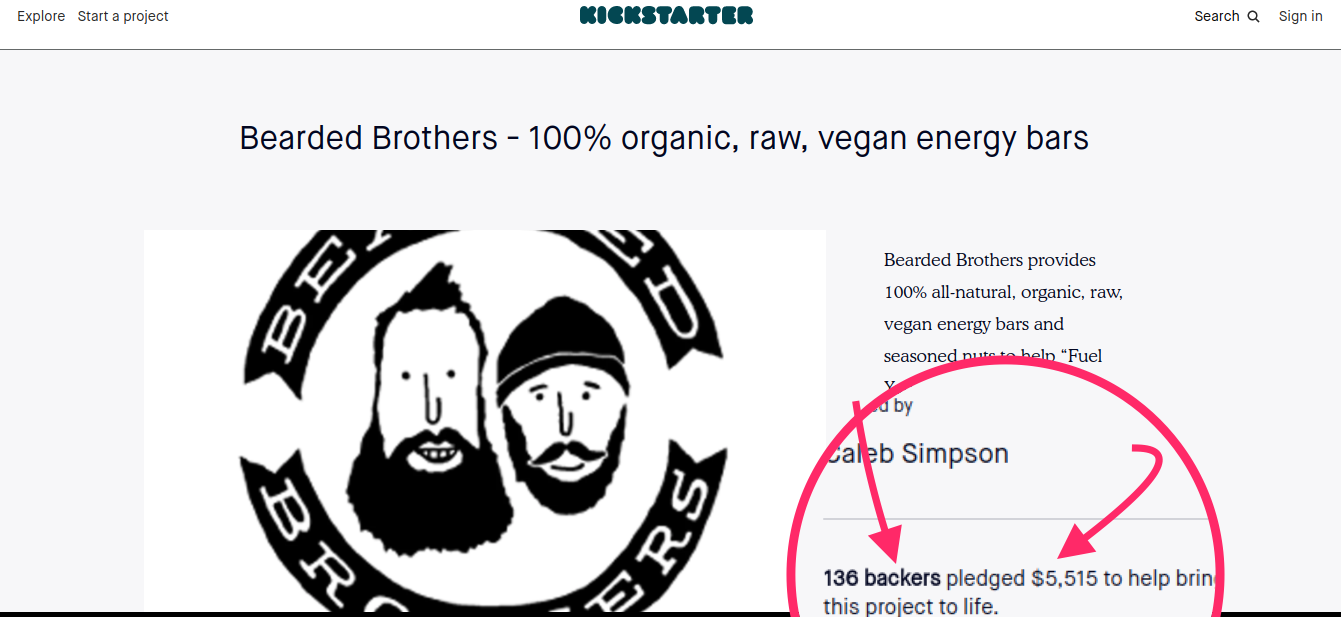
After a failed attempt at Facebook ads, and spending $500 on Google Adwords to yield one conversion, Caleb and Chris found their greatest strength was simple, authentic marketing.
Product Samples
After identifying their main customer as outdoor athletes, Caleb and Chris began offering product samples at local sporting events. They set up booths at 5K runs, rock climbing events, and cycling meets. By handing out tiny samples of their bars, they could sell four cases (48 bars) in three hours—in comparison to six cases (72 bars) a month through online sales.
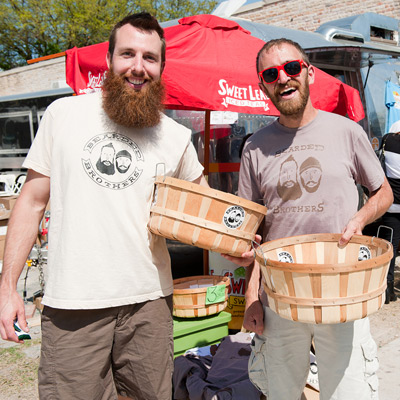
For four years, they sponsored 24 Hours of Horseshoe Hell, a rock climbing event in Arkansas. They worked with event coordinators to have their samples included in participant packets.
Product visibility boosted their credibility. Potential customers saw first-hand the investment Caleb and Chris were making in their business. Product demos also helped Bearded Brothers establish brand recognition with their customers. The customers could speak with Chris and Caleb about the Bearded Brothers bars and lifestyle.
They still host product demos at events, but only in areas where their bars are also sold in stores such as REI, Hy-Vee, and some participating Whole Foods. Caleb believes this makes it easier for customers to purchase the bars after events.
Key Takeaway: Whether you are selling a product or service, it’s never a bad idea to give your customer a taste of what you have. If you are selling a service, such as consulting or designing, display examples of your work, whether it’s a project you managed or image you created. If you are selling a product, go to your customers directly. Build relationships with conference organizers, event planners, online community leaders—anyone in your field. Visibility matters.
Chapter 3: Giving Your Customers Instant Gratification With Cart Casino
Bearded Brothers initial offline sales strategy involved giving away discount coupons with each sample, but they quickly found that most customers are impulsive buyers. When they recognized this, they tested a new online sales strategy using Sumo’s new Cart Casino tool on their website.
Here’s what it looks like (Bearded Brothers used Sumo’s pre-designed Retro-Star Slot Machine template with their logo on it so it matched their branding while being designed to convert):

The Cart Casino game can be activated by clicking on the game tab on the left of the homepage (or automatically on exit intent when someone tries to leave the website). It captures the visitors email and gives them an instant discount on Bearded Brothers products.
Bearded Brothers gave people the chance to win four different discount prizes, each with different probabilities of winning:
Take 15% Off: 67% chance to winTake 20% Off: 29% chance to winTake 40% Off: 3% chance to winTake 75% Off: 1% chance to win
Here are the Cart Casino results:
-
Converted 12% of people who saw it into new email subscribers (3x the conversion rate of their last popup).
-
Converted 10% of people who entered their email to buy Bearded Brothers products.
Based on those results, if you have 100,000 website visitors per month who see your Cart Casino popup, you can expect 1,200 new product sales. To see a detailed breakdown of how Bearded Brothers implemented Cart Casino on their website, click here.
Key Takeaway: Email capture can be a chore. Through gamification, Bearded Brothers tripled their email conversion rate after installing Casino Cart.
Chapter 4: Sending One Monthly Email Campaign To Make 25% To 50% Of Your Revenue
“All they really want is the product.” Caleb on his customers’ behavior.
Caleb mentioned that they did not have to do much to entice their customers to purchase. Their patrons were invested in a quality product from authentic owners. If their bars didn’t have unnecessary additives, why should their brand? It is evident from the Bearded Brothers website that Caleb and Chris take a direct approach.
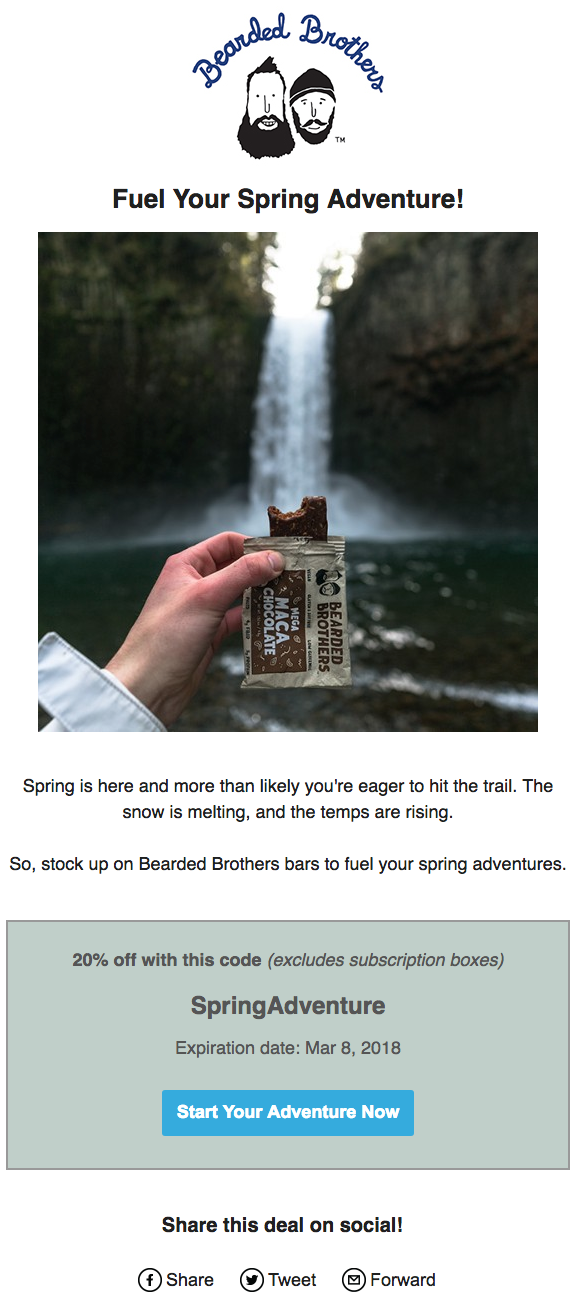
Their last chance email was sent 3 days later and the subject line was “Last day to save 20% off!” They sent the exact same email as above, except in the coupon code section it said “Expires TONIGHT at midnight!".
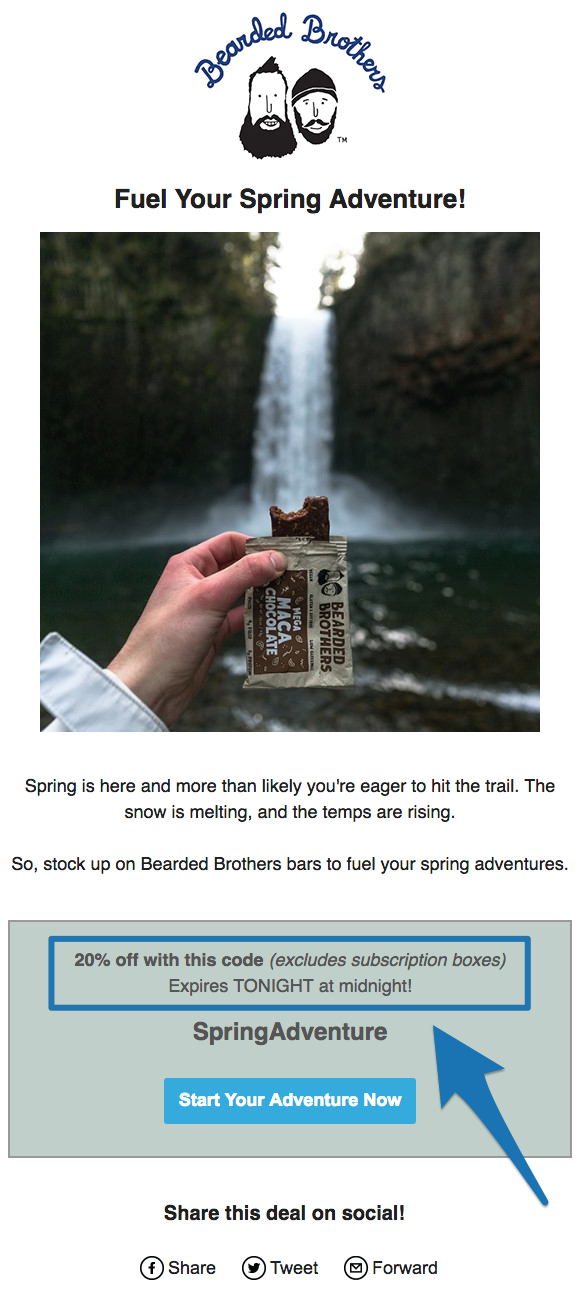
The new subject line coupled with the updated coupon code section encouraged a sense of urgency to take advantage of the sale.
Caleb said that 25% to 50% of their current monthly revenue comes from this one monthly email campaign. People tend to buy more since they are “saving” upfront. “Email is cheaper than Facebook,” Caleb laughs.
Chapter 5: Building A Small Army Of Brand Ambassadors With <10,000 Followers
When it comes to social, you can find Bearded Brothers on Facebook, Twitter and Instagram. Instagram has the most user engagement of the three platforms. To drive engagement, Caleb says they use user-generated content and brand ambassadors. Here’s an example of user-generated content below:

When Caleb and Chris first launched their brand ambassador program, they used a rigorous application process. They were looking for individuals with fewer than 10,000 followers. I asked why fewer than 10,000. Caleb responded, “…in order to have the promotion feel more genuine. I feel that a lot of accounts over 10,000 are too polished and having product posts inserted into their feeds are out of place.”
They started off with 30 brand ambassadors, but had trouble managing them and having them fulfill their agreement to promote. They paid their ambassadors in products, so them not promoting means wasted money. They cut the fat and kept five of the top-performing ambassadors.
They kept five ambassadors based on overall photo quality and awesome product shots. While many insta-influencers ask for a monthly retainer, there still are some who will promote your product because it aligns with their personal brand. Caleb recognizes that the quality of their product is so good, their ambassadors like Miriam Lena (pictured below) are happy to get free products as a perk.

Their ambassadors are a part of the community of outdoor athletes that Bearded Brothers is cultivating.
Working with brand ambassadors like Bearded Bros do can make a big difference for your business. To start cultivating relationships with your own small group of brand ambassadors, use our brand ambassador relationship building worksheet.
Brand Ambassador Relationship Building Worksheet
In addition to the brand ambassador program, cross-promotional marketing also offers great visibility for Bearded Brothers. They select companies that share their vision and mission. For example, they did a giveaway with several outdoor companies including Lems Shoes, Ogden Made and Arbowear.

Here were Branded Brothers cross-promotion results from the Instagram cross-promotion post pictured above:
-
290 likes and 116 post comments
-
1000 new followers from this single post
For a different cross-promotional campaign Bearded Brothers ran recently they generated 450+ email signups, and Caleb is sure they will see sales conversions from it.
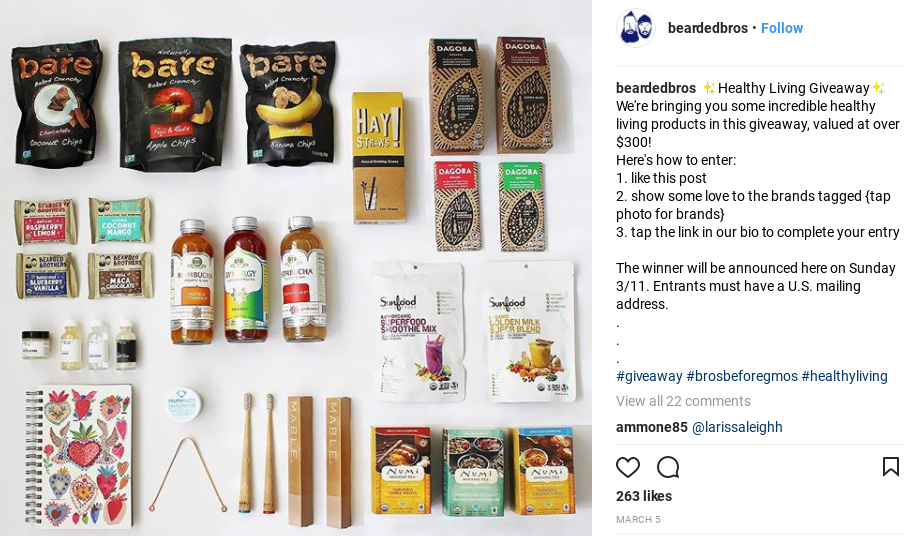
Key Takeaway: Influencers with fewer than 10,000 followers are referred to as “micro-influencers.” Before reaching out to any ambassador/influencer, you want to be sure that their brand aligns with yours. What attributes do they have? What is their engagement like? Do people on social media respond to their posts? You want to create a hassle-free partnership that is mutually beneficial.
Use This Worksheet To Track Your Brand Ambassador Partnerships
Chapter 6: Growing Your Email List With A Monthly Giveaway
As I was speaking with Caleb, he had a goal to grow the Bearded Brothers email list by 1,000 emails by the end of the month. To do it he created a MailChimp email campaign with a giveaway to win a one-year supply of Bearded Brothers energy bars.[*]
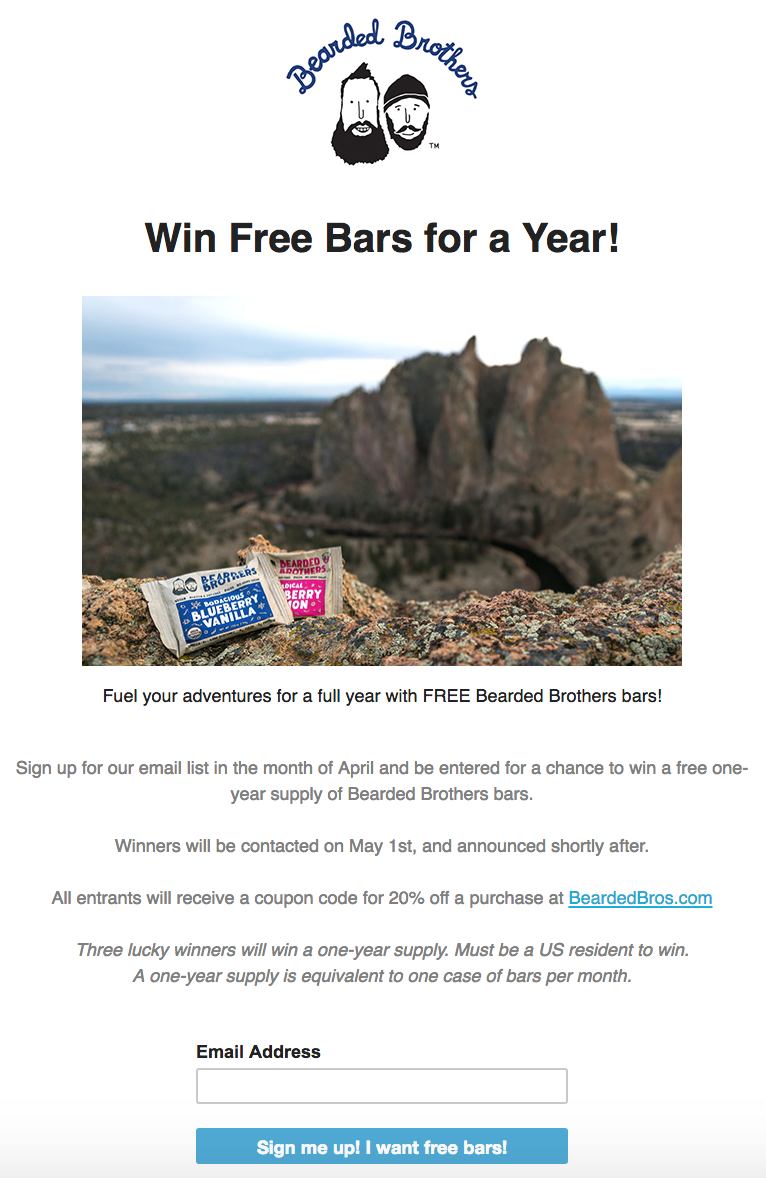
In the first 10 days, the campaign has generated 270 emails. To get these 270 new emails, Caleb has promoted the giveaway by:
-
Posting on Bearded Brothers Instagram
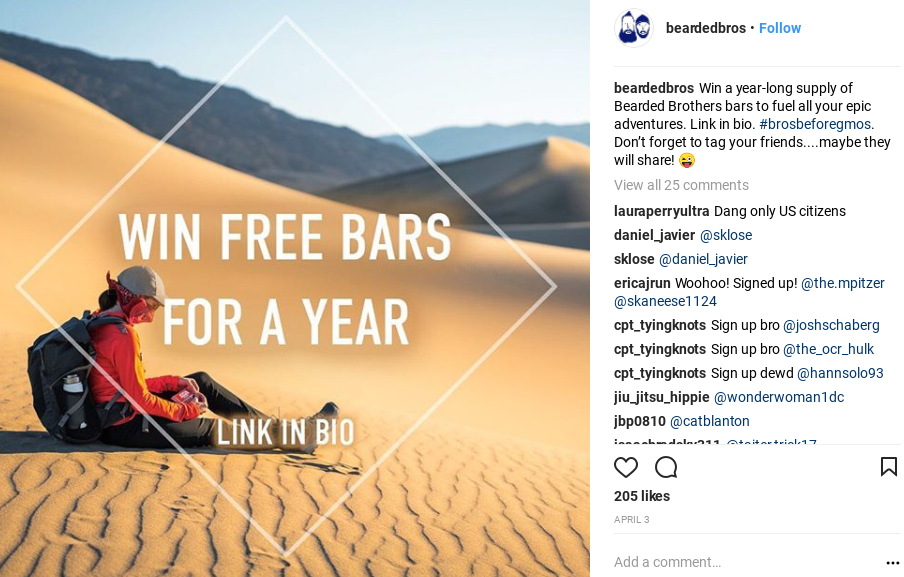
When people go to the bio, they see this (notice how Bearded Brothers keep it simple by using their MailChimp campaign as the landing page):

You can do what Bearded Brothers have done, or try to make your giveaway viral by giving people incentives (like more entries, free product, etc) for sharing your giveaway after they enter using KingSumo.
-
Posting on Bearded Brothers Facebook (pinned post)

-
Posting on Bearded Brothers Twitter (pinned tweet)
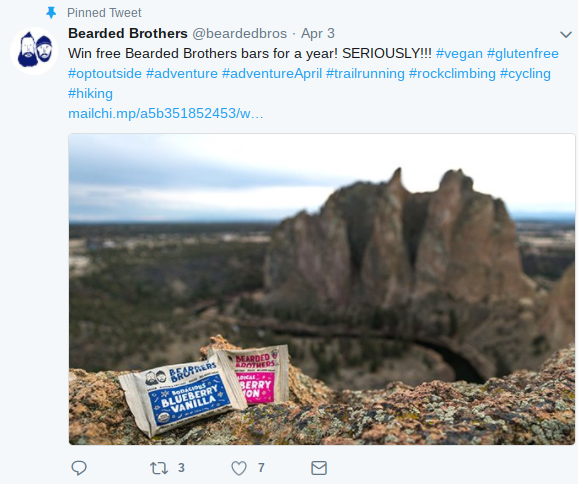
-
Moving forward Caleb plans on intermittently posting this giveaway to their Instagram, Facebook and Twitter throughout the month.
Key Takeaway: Your email list isn’t going to grow itself. Set a goal to grow it (like Caleb did to generate 1,000 emails in 30 days). Then create a giveaway (or some other type of offer) that you can promote to your email list and across your social channels to grow your email list.
Chapter 7: Doubling Your Sales On Amazon
Bearded Brothers are now focused on the direct-to-customer market using Amazon as a conduit. Caleb told me that in the past year Bearded Brothers did about $85,000 in revenue through their online store and $120,000 on Amazon (even though they had product out of stock for a few months on Amazon last year).
Recently they did about $10,000 in revenue on the Bearded Brothers online store and $20,000 in revenue on Amazon in one month. This is likely to be the trend going forward as they have dialed in their Amazon sales strategy.
Bearded Brothers goal is to have their monthly revenue up to $20,000 per month by the end of the year and Amazon revenue up to $50,000. Amazon does way better for Bearded Brothers because it’s a discovery platform. For example a search on Amazon for “whole foods energy bars” gets 90 searches per month.

They get a lot of new customers from the Amazon platform by positioning themselves at the top of Amazon search results like this, and as time goes on many of those become repeat customers because they fall in love with Bearded Brothers products.
Key Takeaway: Think outside-the-box of direct sales on your own online store. Positioning your product on discoverable sites like Amazon where people are actively searching for products like yours can boost your revenue.
Chapter 8: Owning Your Own Mistakes
In 2017, Bearded Brothers encountered a manufacturing setback. To keep pace with demand, they shifted their production to a third party. What happened next almost ruined their business.
Bearded Brothers takes great pride in having a consistent product from taste to packaging. When they gave control to a new company, both of these elements fell apart. Customer feedback about bars bought in stores reported that the packaging and taste were different. Caleb and Chris thought perhaps the manufacturer needed time to adjust.
Unfortunately, the manufacturer did not provide the same quality and consistency. The packaging was noticeably different which turned off some customers. The ingredients also differed from the Bearded Brothers receipt. Caleb and Chris found that they were using unauthorized almonds. Not seeing any improvement, they brought manufacturing back in house, but not before losing $250,000 in retail revenue. Luckily, they still had their equipment, so they were back to normal in no time.

They swiftly released a press statement apologizing to their customers. They took full responsibility for the change in the quality of their product and promised that something like this would not happen again. They found that their core customer base appreciated the honesty and transparency. They did not lose a single person from their email list nor their retail accounts.
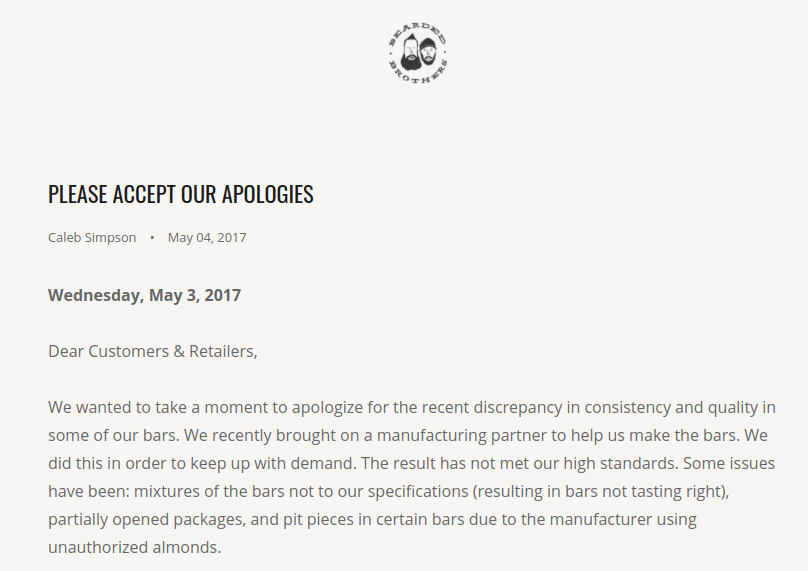
Key Takeaway: Be transparent! Own your failures, because they will happen. Get ahead of the story by issuing a sincere apology and sincere promise to do better. The best way to nail a corporate apology is to be quick, honest and sincere.
What’s Next For Bearded Brothers?
Caleb tells me selling through retail stores is volatile. You can be pulled off the account at any point. While they appreciate their retail partners, Caleb and Chris are focused on growing their email list. Caleb is looking to fine-tune their content marketing strategy, too. He wants to focus more on their core demographic that took them six years to figure out. Lofty plans for a team of five, but after speaking with Caleb for an hour, I am certain the best is yet to come.

Listening to Caleb candidly speak about his company’s simple marketing strategies, shortcomings and all, you now know the real story behind Bearded Brothers business journey. Go check out their organic energy bar empire if you want to start fueling your next adventure with real food. And always remember… “Bros before GMOs.”
Add A Comment
VIEW THE COMMENTS